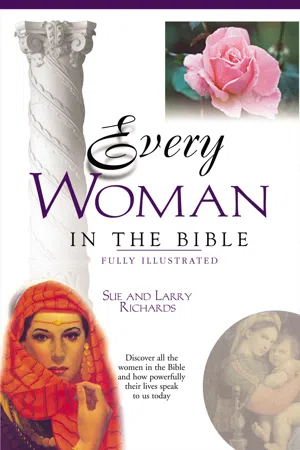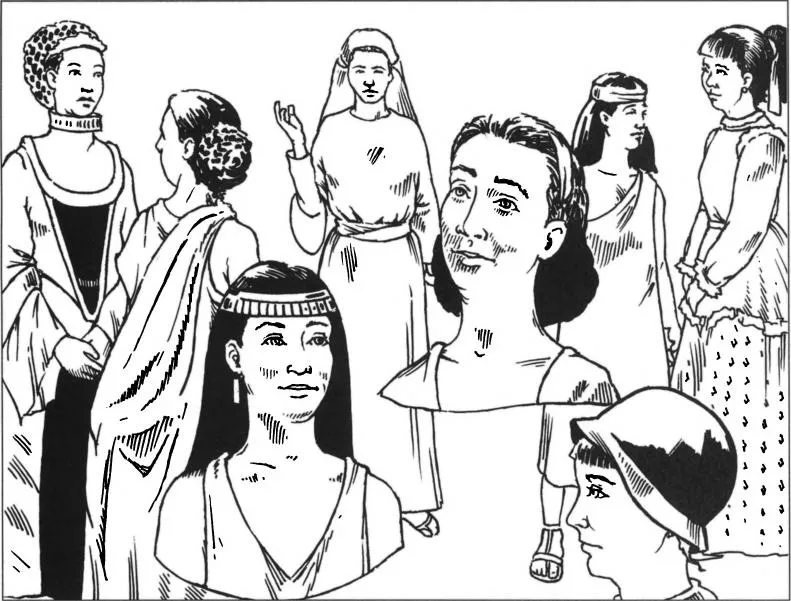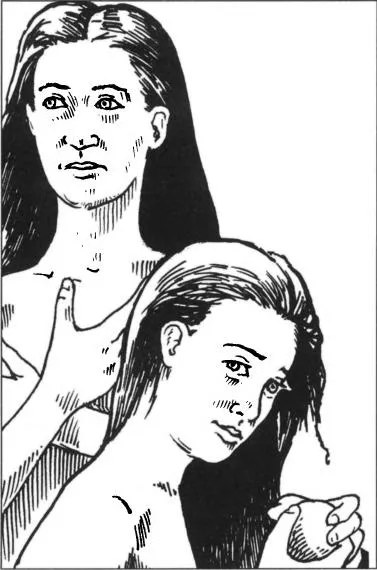CHAPTER 1
WOMAN IN CREATION AND THE FALL
Genesis 1–11
➣ “MAN” EMBRACINGWOMAN WOMAN (Genesis 1:26)—2
➣ THE “OTHERNESS” OF WOMEN—3
➣ HELPER, NOT SERVANT (Genesis 2:18)—4
➣ CONSEQUENCES, NOT CURSES (Genesis 3:16)—5
➣ PSYCHOLOGICAL CONSEQUENCES OF EVE’S FALL—8
Something has happened to Eve’s daughters. We hear it in the chatter of teenage girls, in the strident hostility of radical feminists, and even in our churches, where demands for the ordination of women are countered by the insistence that women are to be silent and submissive.
Some might argue that women are better accepted and understood in today’s world than in the past. Yet recent studies suggest that teacher expectations for boys are still much higher than for girls. Many girls who have intellectual gifts still choose to lie about grades to protect the egos of less gifted boyfriends. In today’s world, pressures on girls to play the feminine role as defined by society have increased rather than decreased. And that role is increasingly difficult to play.
Look for example at society’s physical ideal for women. In the 1950s beauty contest winners tended to be about 5’6” or 5’7” and weigh 140 to 150 pounds. Today’s beauty contest winners are taller and generally 30 to 40 pounds lighter! Yet, today in the United States, women tend to be heavier than in the ’50s and no taller!
As the gap between reality and society’s ideal of feminine beauty is widening, so is the gap between reality and the other expectations society and even the church place on women.
Christians need a clear understanding of what God created women to be. We need to see women as God sees them. With a clear vision of His ideal, women will have a standard by which to measure their aspirations and themselves. Seeing women as God sees them can also enable men to rediscover a wonderful truth: men and women were intended to be true partners in life’s grand adventure.
Thankfully, we have God’s Word, which teaches us about men and women. In God’s Word we meet a number of women who display the qualities and abilities that make for partnership—and that we desperately need to affirm.
In this book we will explore what the Bible teaches about women and seek to correct distortions. As we look carefully at every woman in the Bible, we will better understand humanity’s feminine half.
WOMAN IN CREATION
Genesis 1, 2
The answers to all our most basic questions are found in Genesis. What is the origin of the world? What is special about human beings? What lies at the heart of our male and female identities?
Ideas about the “ideal woman” change from age to age—even ideas about beauty.
These questions and many others are answered decisively in the first chapters of Genesis. Here we find affirmation that the universe is the creation of God who has revealed Himself as a Person. God infused the material world and all living things with structure and order. Genesis 1 immediately defines what is so special about human beings. And Genesis 1 and 2 strongly affirm the common identity of men and women. What do these chapters teach?
MEN AND WOMEN ARE CREATED IN GOD’S IMAGE
Genesis 1:26, 21
Then God said, “Let Us make man in Our image, accordine to Our likeness: let them have dominion over the fish of the sea, over the birds of the air, and over the cattle, over all the earth and over every creeping thing that creeps on the earth.” So God created man in His own image; in the image of God He created him; male and female He created them.”
There are several things we notice in Scripture’s first statement about human beings.
“Man” is a term for the whole human race (Gen. 1:26). The Hebrew word translated man is ˋadam. This familiar word is also the name of the first man, Adam. In most cases we should understand ˋadam as “mankind,” “human beings,” or “humankind.”
Both male and female are included in man. When the biblical text wishes to make a gender distinction, the word ˋish is usually used of male human beings, and the word ˋissah is used of female human beings.
Fear of women led many rabbis to cast Eve as an evil temptress or a silly woman.
Other Hebrew words are used to make a strong sexual distinction. Zakar is used to assert maleness eighty-three times in the Old Testament, and nᵉqebah is used twenty-two times to designate the female.
When God said, “Let Us make man,” He was not speaking of male human beings, but of both men and women. Male and female are equally, and alike, man.
All human beings are created in God’s image (Gen. 1:27). The biblical text takes great pains to maintain the essential equality of the genders. Notice the phrases in Genesis 1:27:
• God created man (ˋadam) in His own image
• Male and female
• He created them
Not only does the text use a word that encompasses all human beings (ˋadam), but to avoid any possible misunderstanding it adds “male and female,” and uses the plural “them.”
God wants us to understand that men and women share the same essential identity. While there are differences between men and women, these are not differences of essence. The essence of humanity, the thing that sets humankind apart from all other living creatures, is that only human beings have been created in God’s image and likeness!
RABBINICAL EMPHASES
The sayings of the rabbis who lived during and after the time of Christ emphasize the “otherness” of women. The supposition was that women were essentially different from men. Rabbinic sages even offered a different explanation of Eve’s Hebrew name, linking it to the Aramaic word for “serpent.” As a result many midrashic stories related about Eve portray her either as a dangerously evil character or as a silly and childish female who was approached by the serpent because she was “light-minded” and vulnerable to his cunning. How different the Eve of the rabbis is from the Eve portrayed in Scripture who, although deceived, was neither venal nor silly.
How striking that stereotypes promoted by men tend to emphasize real or imagined differences between men and women while God’s Word in Genesis emphasizes their essential equality.
The image of God (Gen. 1:26). Genesis 1:26 uses two Hebrew words to communicate the uniqueness of human beings. In the original text the two terms, selem [image] and demut [likeness], are linked. Together they make a grand theological statement: human beings bear the image-likeness of God.
Only human beings possess this amazing gift. While theologians have debated implications of the phrase, we can best understand image-likeness in a simple way. God has revealed Himself as a Person, with all the attributes of personhood. He thinks, plans, remembers, appreciates beauty, establishes priorities, distinguishes right from wrong, makes decisions and carries them out, and so forth. When God made human beings in His image, He gifted us with this same wonderful range of capacities. These capacities of His, reflected in human nature, make us persons too, and constitute the image-likeness of God.
What Genesis 1:27, 28 teach us is that all human beings, men and women, share these gifts equally. Some of us will be more intelligent than others, some more sensitive to beauty. The existence of these and other human capacities, not the amount of any one capacity a person may possess, makes each of us human and reflects something of the glory of a God who possesses every quality to perfection.
What we are always to remember as we look into Scripture’s teaching on women is that women, equally with men, have been gifted by God with His own image-likeness. The women we meet in Scripture display these gifts just as clearly as do the male heroes of our faith.
In essence men and women are the same.
THE CREATION OF EVE
(Genesis 2:18–23)
One of the truly fascinating passages in Scripture is the report in Genesis 2 of Eve’s creation. God created the first man, Adam, and placed him in Eden. There Adam explored the wonders of God’s creation. But wherever Adam looked, he was reminded that something was missing. He could not find another creature like himself.
And the Lord God said, “It is not good that man should be alone; I will make him a helper c...






